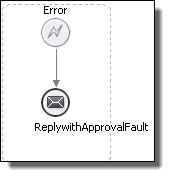Informatica ActiveVOS
- Informatica ActiveVOS 9.2.5
- All Products



<faultHandlers>? <catch faultName="QName"? faultVariable="BPELVariablename"? (faultMessageType="QName" | faultElement="QName")?>* activity </catch> <catchAll>? activity </catchAll> </faultHandlers>
Required Properties
| Optional Properties
|
|---|---|
Catch only:
Fault name only or fault variable only or fault name plus fault variable
| Catch only:
Fault name, Fault variable definition, Fault variable
|
Comment. See Adding Comments to a Process
| |
Documentation. See Adding Documentation to a Process
| |
See Setting Visual Properties and Using Your Own Library of Images.
| |
Execution State. See Viewing the Execution State of an Activity or Link
| |
Extension Attributes and Extension Elements. See Declaring Extension Elements and Attributes.
|
<catchAll> <sequence> <compensate/> <rethrow/> </sequence> </catchAll>